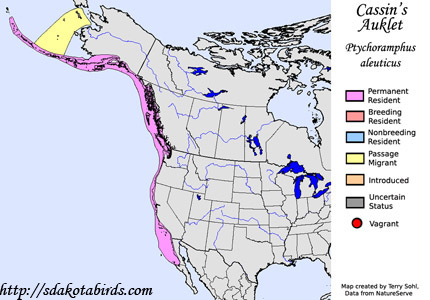| Length: 9 inches | Wingspan: 15 inches | Seasonality: Non-resident in South Dakota |
| ID Keys: Gray overall, chunky appearance, lighter eye with small white spot above it, thick triangular bill | ||
 The
Cassin's Auklet is a widespread auk species that's found on the Pacific
coast from Alaska to Mexico. Both their range and total population are
greater than other auk species found in the Pacific. They rely less on
specialized island habitats than other auk species (for example, the need
for rocky offshore islands for many auk species in the Pacific), and will
nest near many different island habitats, as long as nesting burrows can be
built, and predators aren't prevalent. Overall, their distinguishing
characteristic compared to other Auklet species is the lack of distinct
plumage marks, as they are decidedly plainer than other Auklet species in
their range.
The
Cassin's Auklet is a widespread auk species that's found on the Pacific
coast from Alaska to Mexico. Both their range and total population are
greater than other auk species found in the Pacific. They rely less on
specialized island habitats than other auk species (for example, the need
for rocky offshore islands for many auk species in the Pacific), and will
nest near many different island habitats, as long as nesting burrows can be
built, and predators aren't prevalent. Overall, their distinguishing
characteristic compared to other Auklet species is the lack of distinct
plumage marks, as they are decidedly plainer than other Auklet species in
their range.
Habitat: Nests on islands free of terrestrial predators, with a habitat preference much less selective than many other auklet species. Outside of the breeding season, they are often found near their breeding colonies, but they can also be found far out to sea.
Diet: Feeds on small crustaceans such as copepods, small shrimp, amphipods, and occasionally fish, squid, marine worms, and other sea creatures.
Behavior: Feeds by swimming underwater in pursuit of food items. They are capable of diving to over 100 feet deep.
Nesting: Nesting occurs in a burrow dug in the ground, with both the male and female helping to excavate then nesting cavity. No nesting material is used in the burrow; the female lays a single egg on the burrow floor. Both parents help to incubate the egg, and both parents help raise the young after it hatches.
Song: On breeding colonies, Cassin's Auklets have a variety of hoarse calls. They are silent away from breeding grounds.
Migration: Birds at the far northern part of their range do move southward for the winter. However, birds in most of their range are considered permanent residents.
Interactive eBird Map: Click for access to an interactive eBird map of Cassin's Auklet sightings
Similar Species: Generally plainer than other Auklet species, with a thicker bill and body shape than Murrelet species. If seen well in range, it's unlikely to be confused with another species.
Conservation Status: Populations have been in decline, but they are still found over a very wide geographic range and are common in many areas. The IUCN lists the Cassin's Auklet as a species of "Least Concern".
Further Information: 1) Alaska Seabird Information Series - Cassin's Auklet
2) Audubon Guides - Cassin's Auklet
3) BirdWeb.org - Cassin's Auklet
Photo Information: Photo taken by Duncan - August 2003 - Farallon Islands, off the coast of California - Photo licensed under Creative Commons Attribution ShareAlike 2.0 Generic License.
| Click below for a higher-resolution map |
 |
| South Dakota Status: Non-resident in South Dakota |
Additional Cassin's Auklet Photos (coming soon!!)
